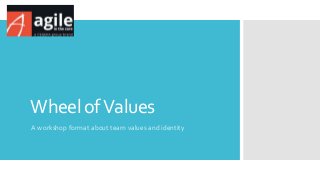
Wheel of values - About Team Values, Behaviour and Identity
- 1. Wheel ofValues A workshop format about team values and identity
- 2. 1.Set the Stage Welcome Kerth’s Prime Directive "Regardless of what we discover, we understand and truly believe that everyone did the best job they could, given what they knew at the time, their skills and abilities, the resources available, and the situation at hand.“ (Norm Kerth, Project Retrospectives: A Handbook forTeam Review) Telephone line game (communication) Setting : team either sits around a table or stands up in a line. Say a sentence and pass it on, whispering “As a team member I want to know who I work with and what values they hold dear, so I can better understand them and we can become a great team”. 10’ 0’
- 3. 2.Gather data Introduce the Wheel ofValues The wheel of values is a model that helps us think about behaviour and values. Image that you go to sleep one day and the next day you get to the office and your dream team has come true. How does this look like? Identity Behaviour Values
- 4. 2.Gather Data Round 1 : Ask the team : What kind of behaviour do you expect in your ideal team? What kind of behaviour do you see, hear ? Give them 5 to 10 minutes to write behaviour on post-its. Ask them to put the post-its in the outer circle, you may ask them to cluster similar behaviour as they see fit.You may also indicate that they can use the spokes to cluster similar behaviour. Behaviour
- 5. 2.Gather data Round 2: VersionA : Ask the team to gather around the wall or table where theWheel displayed and have them take a few minutes to read all the post-its with the behaviour on it. Let them cluster or re-cluster as they see fit. Clarification and discussion may arise.Timebox it. Then ask the team : What values drives the behaviour that is on the wheel ? What values or beliefs are behind the behaviour on the wheel? Give the team 5 to 10 minutes to write down the values. Have them put the values in the second circle and in the section that corresponds with the behaviour Values
- 6. 2.Gather data Round 2: Version B : Read the post-its with behaviour out loud and ask for clarification if you deem necessary. Help the team to cluster or re-cluster as they see fit. Clarification and discussion may arise.Timebox it. Then ask the team : What values drives the behaviour that is on the wheel ? What values or beliefs are behind the behaviour on the wheel? Give the team 5 to 10 minutes to write down the values. Have them put the values in the second circle and in the section that corresponds with the behaviour. Values
- 7. 2.Gather Data Round 3 : Ask the team to use the values to come up with a word, an image, a logo, or another symbol of their team’s identity. Give them 10 to 15 minutes to come up with a symbol. If you need to structure the discussion you can have them write ideas on post-its and put them on a table of wall, then let the team vote on the most appealing symbol. Identity
- 8. 3.Generate insights Select the most important values. Some options : Have the team discuss and select the 5 most important values to them. Let the team pick the 5 most important values by voting. You can use simple techniques like : dot voting, hand voting, … ) Then let the team establish on how well they think they are living up to those values: (careful with this) You can use the same simple techniques of dot voting or hand voting. 1 • Courage 2 • Respect 3 • Openness 4 • Discipline 5 • Trust
- 9. 4. Define Actions Actions, Actions, Actions (smart one’s if possible) Let the team define action on how to improve. Start with the value that they feel will have most impact or the one that they think needs most improvement. By suggesting behaviour By making agreements … •Value 1 •Action … .Action 1 Action 2 Action 3
- 10. 5.Close the retro Commitment is important. Ask to sign theWheel ofValues as a sign of agreement and commitment to live up to the values. Commit to help each other and act in accordance with the values Ask for feedback about the session. Tell the team to take the wheel with them if they want and use the symbol (name, totem, logo, image) as a reference to the team and the values they believe in.
- 11. Agile in the Core The team of experience Agile and Agility coaches at Agile in the Core (*) has helped to transform many teams and organisations to become agile in mind and method. If you have a team that needs help in agile methods, mindset or tools, If you want to transform your organisation to an agile enterprise : Find us at http://agileinthecore.com Or contact me at mailto:franky.redant@cegeka.be (*)Agile in the Core is a Cegeka Group brand.
